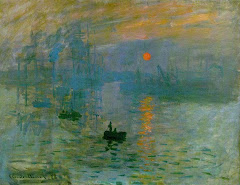Bibliographic reference:
Igor Berezhnoy, Eric Postma and Jaap van den Herik, Computer analysis of Van Gogh's complementary colours.
Available at: http://www.ai.rug.nl/conf/bnaic2004/ap/a39.pdf
Extract:
3.3. Opponent-colour Analysis
Application of the opponent-colour transform yields three images (one for the luminance channel and one for each chrominance channel). Since our analysis focusses on opponent-colour transitions, the two chromatic-channel images are convolved with odd and even Gabor filters in four orientations (horizontal, vertical and along both diagonals) and at four scales. For the four scales, the support for the Gabor filters measured 82, 162, 322, and 642 pixels. The opponency for each channel is defined as the total energy averaged over the orientations and scales and divided by the number of pixels in the image. The opponency value for a painting equals the summed opponencies of the red-green and blue-yellow channels.
Title: Digital analysis of Van Gogh’s complementary colours
Creator: Igor Berezhnoy, Eric Postma, Jaap van den Herik
Subject: art paintings/ Vincent van Gogh/ digital analysis/ complementary colours
Description: "Traditionally, the analysis of visual arts is performed by human art experts only. The availability of advanced artificial intelligence techniques makes it possible to support art experts in their judgement of visual art. In this paper image-analysis techniques are applied to measure the complementary colours in the oeuvre of Vincent van Gogh. It is commonly acknowledged that, especially in his French period, Van Gogh started employed complementary colours to emphasize contours of objects or parts of scenes. We propose a method to measure complementary-colour usage in a painting by combing an opponent-colour space representation with Gabor filtering. Using this method, the analysis of a dataset of 617 digitised oil-on-canvas paintings confirms artexpert’s knowledge about the global pattern of complementary-colour usage in Van Gogh’s paintings. In addition, it provides an objective and quantifiable way to support the analysis of colours in individual paintings. Our results show that art experts can be supported by artificial-intelligence techniques."
Publisher: IKAT/Computer Science,
Date: None
Type: Text
Format: Pdf
Source: None
Language: En
Coverage: International
Rights: IKAT/Computer Science,




Aucun commentaire:
Enregistrer un commentaire